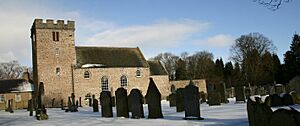Monymusk Priory facts for kids
Monymusk Priory was an important religious house in Monymusk, Aberdeenshire, Scotland. It was home to a group of religious men called Augustinian canons. These canons were like priests who lived together in a community. The priory started as a place for an older group of monks called Culdees. Later, it changed and became an Augustinian priory.
Contents
History of Monymusk Priory
Early Beginnings and the Culdees
The first religious people to settle in Monymusk were known as Culdees. They might have come from a place called Whithorn. An old stone from the 800s, called a Pictish stone, was found nearby. You can see it today at the Church of the Blessed Mary in Monymusk.
In 1130, the Culdees were given land at Monymusk. This suggests there was already a religious group living there. They had special rights, like having a place to sleep, eat, and pray. They could also bury their dead in the local cemetery.
Building the Priory Church
A beautiful church was finished in the mid-1100s. It was built in the Romanesque style, which means it had thick walls and round arches. Gille Críst, who was a powerful local leader called the Mormaer of Mar, built a monastery there. This happened in the late 1100s.
The church likely served two purposes. It was a parish church for the local people. It was also the main church for the canons who lived at the priory. The part of the church where the canons prayed was unusually long.
Life as an Augustinian Priory
By 1245, the religious community had fully changed. It became an Augustinian priory. At this time, it had a leader called a Prior and eleven canons. Life at the priory was busy.
The priory had its own school for learning. There were also three gardens where food was grown. They had a small farm, called a croft, and areas for animals to graze. Many buildings were part of the monastery. There was even a fish-pond for food. The canons also had two small chapels, called oratories, about two miles away.
Control and Decline
The St Andrews Cathedral Priory had some control over Monymusk Priory. However, the bishops from St Andrews and Aberdeen often argued about who was in charge. For a while, Monymusk Priory also looked after the Monymusk Reliquary. This was a special container for holy items.
By the early 1500s, the priory started to face difficulties. The last religious Prior, David Farlie, left his position. In 1542, a new type of leader took over. This was a lay commendator named John Elphinstone. A lay commendator was a person, often not a priest, who managed the priory's property.
In 1554, a fire badly damaged the priory. The canons did not have enough money to rebuild it. Around 1587, the Forbes family used stones from the old priory. They used these stones to build the current House of Monymusk. In 1617, the priory's lands became part of the bishopric of Dunblane. The church itself continued to be used by the local community for worship.
See also
- Prior of Monymusk, for a list of priors and commendators


